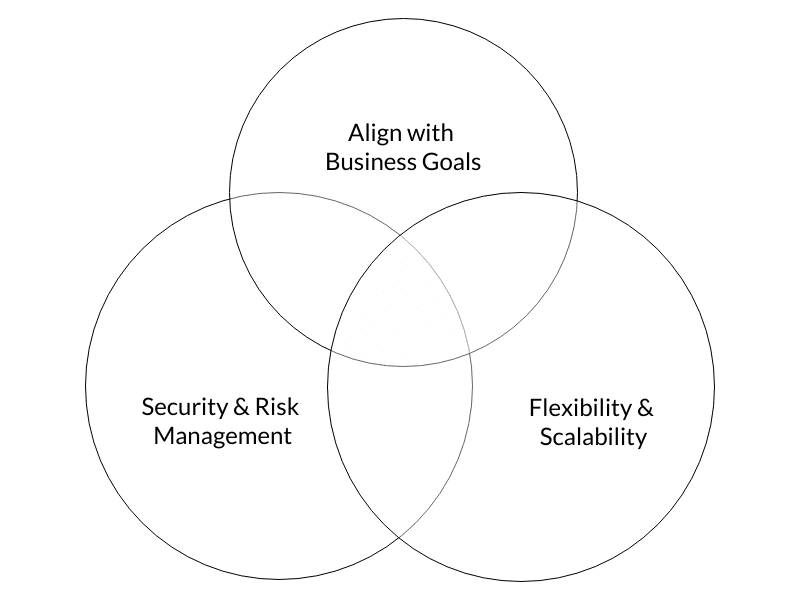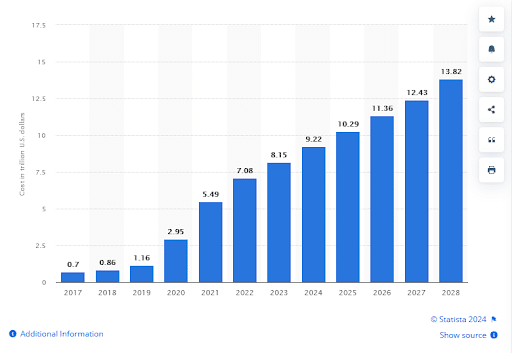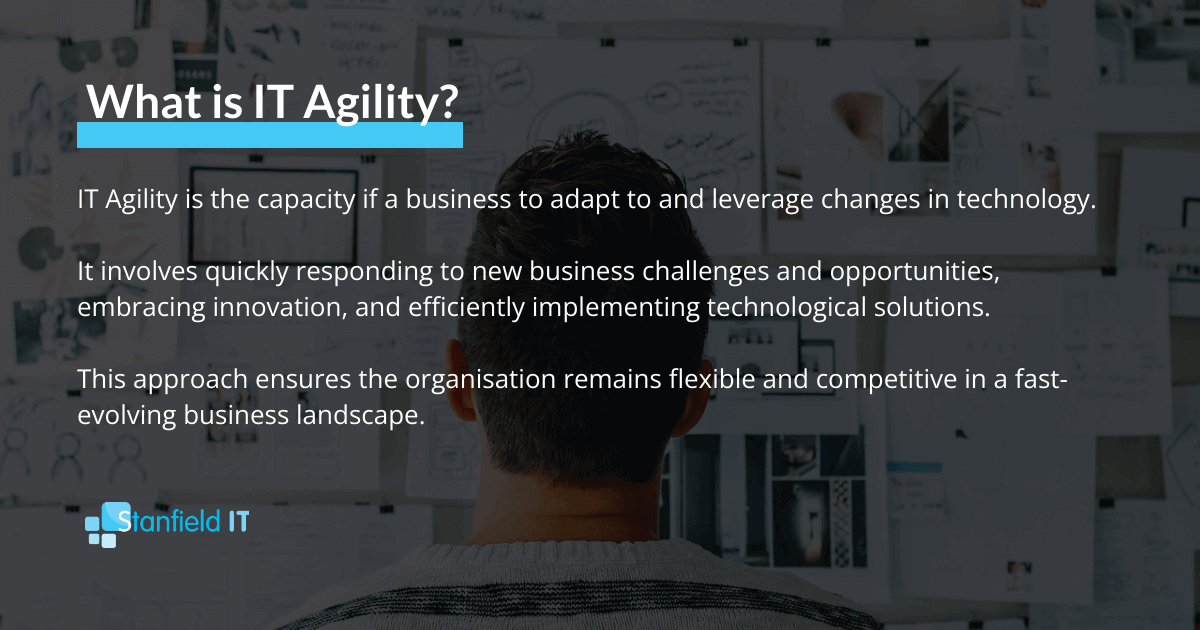In business, your strategy communicates how you will win.
Your IT strategy therefore communicates how you will win using technology.
It’s about making technology choices that directly impact your company’s market position and operational effectiveness.
An effective IT strategy isn’t just about keeping up with tech trends, it’s about selecting and implementing technology that aligns with and drives your specific business objectives.
In this article, we’ll discuss seven straightforward, actionable ways to enhance your IT strategy, focusing on tangible outcomes like improved efficiency, cost savings, and competitive advantage.
Get Your Free Essential Eight Cyber Security Report
Learn:
-
- The cyber security gaps costing you time and money.
- Practical steps to upgrade your security measures.
- The hidden risks of poor security protocols.
- How to bolster your cyber security and aid business growth.
What is an IT Strategy?
An IT strategy is a roadmap detailing how technology will be used to support and enhance an organisation’s overall business goals. It’s a crucial part of the broader business strategy, focusing on leveraging technology for organisational success.
This strategy encompasses not just the selection and implementation of technologies but also addresses how technology impacts every aspect of the business.
Key components of an IT strategy include:
- Technology Investment and Infrastructure: Decision about the technology tools and infrastructure that will best support the company’s goals.
- Systems Architecture and Data Management: The framework for managing data and information systems in a way that supports business processes and decision-making.
- Cyber Security Framework: Develop and maintain robust security protocols to protect business and customer data.
- Staff Training and Development: Ensuring that the workforce is equipped with the necessary skills and knowledge to effectively utilise the technology.
- Innovation and Future Planning: Keeping an eye on emerging technologies and industry trends to maintain a competitive advantage.
Remember, it’s not the plan that matters, it’s the execution. The real power of an IT strategy is in its deployment – the nuts and bolts of how you integrate and manage various tech components to drive your business goals.
It’s about making these elements work together, not in silos.
You don’t need or want a static plan. What you need is a living, breathing strategy. One that’s adaptable, responding in real-time to shifts in your business landscape, market trends, and tech innovations. It’s this flexibility and resilience that turns a good IT strategy into a great one.
What Makes a Good IT Strategy?
Good IT strategy needs to break down complex systems and interrelationships. But what makes a good IT strategy? Fundamentally, it boils down to a few key principles:
- Alignment with Business Goals: The core of a good IT strategy is its alignment with your business objectives. You want to ensure that every technology decision and investment you make will contribute to the overall success and goals of the business.
- Flexibility and Scalability: No matter how strong your strategy or strategist is, you can’t predict the future. Technology advances, so your IT strategy must be both flexible and scalable. It should adapt to changing business needs and technological landscapes, allowing for growth and the incorporation of new and emerging technologies that can offer competitive advantages.
- Security and Risk Management: Cyber security and data protection should be a priority for all businesses. A successful IT strategy integrates strong security measures and adheres to relevant regulations to protect digital assets and customer data.

7 Ways to Nail Your IT Strategy
1. Aligning IT and Business Objectives
As mentioned above, the cornerstone of a strong IT strategy is its alignment with your business objectives.
What does this mean?
It means every IT decision, from software selection to infrastructure development, should directly support the broader goals of your business.
For instance, if your business goal is to improve customer service, your IT strategy might prioritise investments in customer relationship management (CRM) software or AI-powered chatbots.
Key Action Points
- Conduct regular meetings between IT and business leaders to ensure alignment.
- Develop a clear understanding of business goals across IT teams.
- Use technology to directly address business challenges, like automating processes for efficiency or using data analytics for better decision-making.
2. Investing in Scalable Technologies
Your IT needs to evolve as your business grows. Investing in scalable technologies ensures that your IT infrastructure can grow and adapt as your business requires.
Scalable solutions like cloud computing offer flexibility and scalability. This allows you to increase or decrease your resources as needed.
This not only helps in managing costs but also ensures that your business can rapidly respond to market changes and opportunities.
- Projected Spending Surge: By 2027, global digital transformation spending is set to reach nearly $3.9 trillion.
- Growth Rate: Expect a compound annual growth rate of 16.1% from 2023 to 2027.
- Driving Factors: This growth underscores the importance of scalable digital technologies in enabling businesses to evolve and grow.
- Key Insights: Scalable technologies are critical in supporting the rapid pace of digital transformation, allowing businesses to adapt and thrive in a changing landscape.
Key Action Points
- Assess your current and future IT needs as part of your strategic planning.
- Choose technologies that offer scalability and flexibility, like cloud services or modular software systems.
- Plan for long-term growth when making tech investments. Avoid short term fixes that may not scale easily.
Don't miss out on our latest.
Join our subscribers and receive expert insights on cyber security and IT. Sign up now!
3. Prioritising Cyber Security and Compliance
We’re seeing more frequent data breaches these days. So, prioritising cyber security is an integral part of any business strategy.
A strong IT strategy must include proactive measures to protect data and systems. This also involves ensuring compliance with data protection regulations, which is crucial for maintaining customer trust and avoiding legal penalties.
Key Action Points
- Implement comprehensive security protocols and regular vulnerability assessments
- Stay updated with compliance requirements relevant to your industry and region.
- Train employees regularly on security best practices and awareness.
The cost of cybercrime 2017-2028 – Statista

4. Embrace Data-Driven Decision Making
Data is a goldmine for strategic insights, and a smart IT strategy leverages this. By embracing data analytics, your businesses can make more informed decisions, make better decisions, identify new opportunities, and personalise customer experiences. This involves investing in the right tools and skills to analyse and interpret data effectively.
Key Action Points
- Invest in analytics tools that align with your specific business needs
- Foster a culture where data-driven insights are used for strategic decision making.
- Regularly review and analyse data to identify trends and insights that can drive business growth.
5. Fostering an Agile IT Culture
An agile IT culture will help your business stay relevant in an evolving tech landscape.
This means being open to change, encouraging innovation, and being able to adapt to new technologies and market shifts quickly.
An agile IT strategy supports continuous improvement and rapid response to change.
Key Action Points
- Encourage a culture of continuous improvement and flexibility within the IT team.
- Implement methodologies like Agile and DevOps to improve efficiency and responsiveness.
- Regularly explore and experiment with new technologies and approaches.

6. Optimising IT Budget for Maximum ROI
A sound IT strategy isn’t only about choosing the right technologies but also about optimising your IT budget to ensure maximum return on investment.
This involves making strategic decisions about where to allocate resources and derive the greatest business value.
It’s crucial to balance between current needs and future growth, ensuring that each dollar spent contributes directly to business objectives.
Key Action Points
- Conduct a thorough cost-benefit analysis for each proposed IT investment.
- Seek opportunities to reduce costs without sacrificing quality, such as through cloud services or open-source software.
- Regularly review and adjust IT spending in line with business performance and objectives.

7. Regularly Reviewing and Updating the IT Strategy
The tech world is dynamic, and what works today may be less effective tomorrow.
Regularly reviewing and updating your IT strategy is essential to ensure it remains aligned with both your evolving business goals and the latest technological advancements.
This practice helps in identifying areas for improvement, adapting to new market conditions, and seizing new opportunities as they arise.
Key Action Points
- Schedule periodic reviews of the IT strategy, involving key stakeholders from different departments.
- Stay informed about emerging technologies and industry trends that could impact your business.
- Foster a feedback culture where input from IT staff and end-users is used to refine and improve the strategy.
Conclusion
In the end, crafting an IT strategy isn’t just about drafting a document; it’s about creating a playbook for technological success. A playbook that’s as dynamic as the tech world itself. Remember, a strategy that’s worth its salt is one that’s put into action – effectively and adaptively.
Your IT strategy should be a living entity, constantly evolving just like your business and the tech landscape. It’s not set in stone. It’s an ongoing process of assessing, adjusting, and advancing. Embrace this fluidity. Be ready to pivot when needed to, capitalise on new technologies, and meet changing market demands head on.
In this digital arena, the winners are those who not only plan but execute with agility and foresight. So, take these insights, mould them into your strategy, and prepare to lead your business not just to compete but to dominate in your field.
More Like This
Windows 10 End of Life (EOL) and What it Means
Microsoft has announced that October 14, 2025, will be the End of Life (EOL) date for Windows 10. Windows 10 EOL is set to affect all versions of Windows 10, including Home, Pro, Education, and Enterprise. Research from Lansweeper indicates that only 23.1% of...
ISO 27001 Certification in Australia: A Comprehensive Guide
Business data is like a treasure for cyber criminals. In fact, buried in almost every organisation's information assets are details worthy of holding ransom. So, how do you protect it? With ISO 27001 certification. ISO 270001 is more than just a standard industry...
Cyber Hygiene For Business: What You Need To Know
Implementing cyber hygiene practices is one of the most effective ways to protect your business from cybersecurity risks. As a business owner, the security of your company's data is paramount. With the prevalence of cyber-attacks in the modern world, it’s increasingly...



